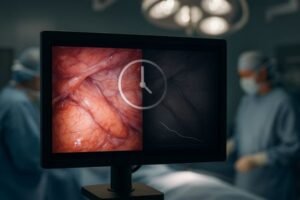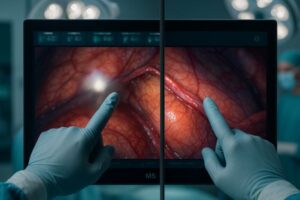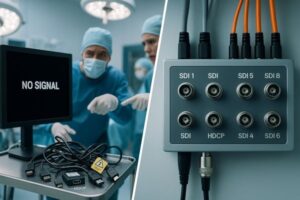Choosing the right medical display can feel overwhelming. With so many panel technologies available, making the wrong choice can compromise diagnostic accuracy and lead to a poor return on investment.
The most common panel types in medical displays include:
– IPS: For color accuracy and wide viewing angles.
– VA: For high contrast.
– OLED: For true blacks and fast response.
– TFT: For cost-effective basic uses.
Choosing the right panel depends on the specific clinical application.
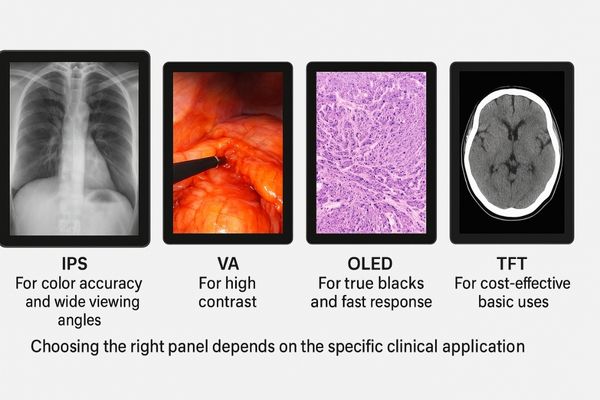
The screen you look at is the final and most critical link in the entire medical imaging chain1. The technology inside that screen, known as the display panel, dictates how accurately and consistently an image is presented. A panel optimized for a radiologist’s reading room is fundamentally different from one suited for an operating room or a patient monitoring station. Understanding these differences is not just a technical exercise; it is essential for ensuring that clinicians have the best possible tool for making confident decisions. This article will provide a clear overview of the main panel technologies2 used in medical displays today, helping you understand their specific strengths and weaknesses in various clinical settings.
IPS Panels Offer Wide Viewing Angles and Color Accuracy
Colors on a screen shift when viewed from the side. During a group consultation, this inconsistency can lead to different interpretations of the same image, creating confusion and potential diagnostic errors.
IPS panels maintain exceptional color and brightness consistency even at very wide viewing angles. This makes them the standard for collaborative environments like radiology reading rooms and operating theaters, where multiple people must see the same accurate image.
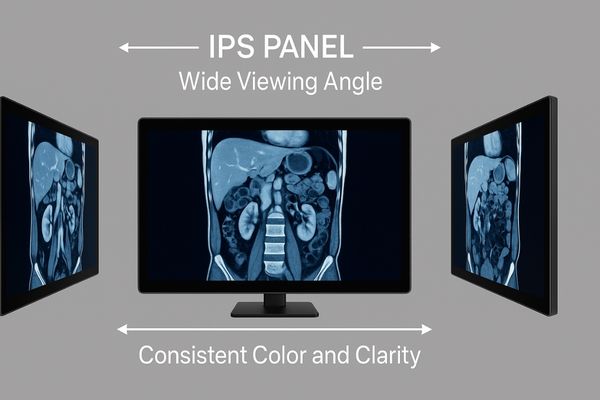
In-Plane Switching (IPS) technology3 works by aligning liquid crystals parallel to the glass substrates of the display. When a voltage is applied, the crystals rotate "in plane" to let light pass through. This unique structure is the reason for its two main advantages: superior viewing angles and color fidelity. An IPS panel provides a consistent image across a viewing arc of up to 178 degrees, both horizontally and vertically. This means a surgeon standing across the operating table sees the same clear, accurate image as the primary surgeon. It also allows a radiologist to consult with colleagues standing beside their desk without anyone seeing a distorted picture. This consistency is also critical for grayscale rendering. IPS panels excel at displaying subtle shades of gray, which is a requirement for meeting the DICOM Part 14 standard4 for medical imaging. For the most demanding multi-modality diagnostic tasks, where both color and grayscale accuracy are paramount, a display like our MD120C – 12MP High-Precision Diagnostic Monitor with AI Calibration leverages a premium IPS panel to ensure unparalleled image quality.
VA Panels Deliver High Contrast but Limited Viewing Range
You need to distinguish subtle details in dark areas of an image. However, the displays you have used wash out when you move your head slightly, causing diagnostic uncertainty.
VA panels offer very high native contrast, making blacks appear truly deep and enhancing detail in darker image regions. However, this advantage comes at the cost of narrow viewing angles, which can cause significant color and contrast shifts off-axis.
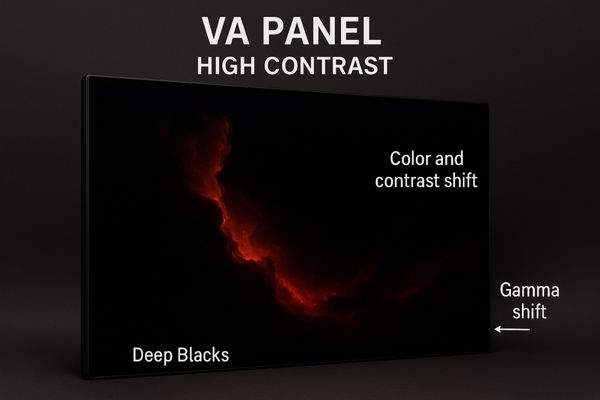
Vertical Alignment (VA) panels position their liquid crystals perpendicular to the glass substrate. When no voltage is applied, they effectively block the backlight, producing very deep black levels. This gives VA panels a significant advantage in native contrast ratio5, often achieving 3000:1 or more, compared to the typical 1000:1 of an IPS panel. This high contrast is excellent for viewing images where the distinction between subtle dark shades is critical, such as certain types of X-rays. The main drawback, however, is performance at an angle. As the viewer moves off-center, the alignment of the crystals causes a phenomenon known as "gamma shift6," where dark gray details can be lost or "crushed" into black. Colors can also appear washed out. This makes VA panels a poor choice for any collaborative setting. They are best suited for single-user applications where the viewer remains directly in front of the screen. A model like the MD22CA – 2MP Diagnostic Monitor can be a cost-effective option for specific review stations where high contrast for a single user is the priority.
Panel Technology Comparison: VA vs. IPS
| Feature | VA (Vertical Alignment) Panel | IPS (In-Plane Switching) Panel |
|---|---|---|
| Native Contrast | High (e.g., 3000:1) | Standard (e.g., 1000:1) |
| Black Levels | Deep, dark blacks | Good, but can appear grayish |
| Viewing Angle | Limited, with color/contrast shift | Wide (up to 178°) with consistency |
| Best For | Static images for a single viewer | Collaborative review, color-critical work |
OLED Displays Enable True Blacks and Thin Designs
You want the absolute best contrast with a modern, thin design. Yet, you are concerned that the display’s performance will degrade over time, leading to image retention issues.
OLED displays have self-emissive pixels that can turn off completely, delivering perfect black levels and infinite contrast. This technology allows for very thin and light monitors but faces challenges with long-term lifespan and potential image burn-in in medical settings.
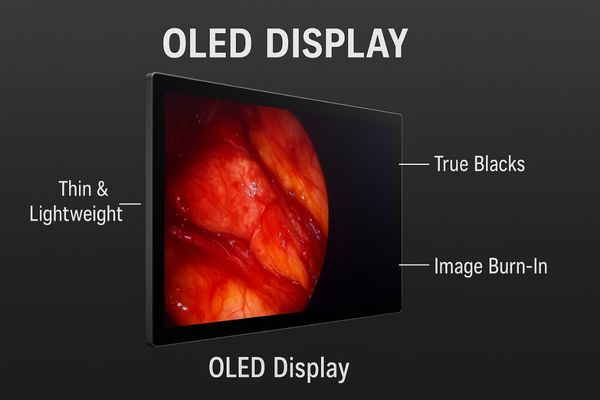
Organic Light Emitting Diode (OLED)7 technology represents a major departure from traditional LCD panels. Instead of using a single backlight that is filtered by liquid crystals, each individual pixel in an OLED display is its own light source. When a pixel needs to be black, it simply turns off completely. This results in a theoretically infinite contrast ratio and an image with incredible depth and vibrancy. Because there is no backlight layer, OLED panels can be made exceptionally thin and lightweight. They also offer nearly instantaneous response times, which is excellent for eliminating motion blur in dynamic imaging like cardiology. However, the technology has two significant drawbacks for continuous clinical use. First, the organic compounds used to create light degrade over time, with blue pixels degrading the fastest, which can lead to a shift in color balance. Second, if a static image is left on the screen for too long, it can cause "burn-in8," where a faint ghost of the image remains permanently. While challenging for static PACS displays, OLED is a promising technology for applications like endoscopy, where the on-screen image is constantly moving. A model like our MS220S – 22" FHD Endoscopic Monitor is ideal for this use case, where the benefits of perfect contrast and color are a primary concern.
TFT Panels Remain Cost-Effective for Basic Applications
You need to equip a nurse’s station with a display for viewing patient data. A high-end diagnostic monitor is unnecessary and too expensive for this simple task.
TFT is the foundational transistor technology in modern LCDs. When used to describe a basic display, it typically refers to a TN (Twisted Nematic) panel. These panels are a cost-effective and reliable choice for non-diagnostic applications like displaying patient vitals or information.

The term TFT, or Thin-Film Transistor9, can sometimes be confusing. A TFT is the microscopic switching transistor that controls each pixel, and it is a component of all modern LCD panel types, including IPS and VA. However, in common industry language, "TFT display" is often used as shorthand for the oldest and most basic type of LCD panel: Twisted Nematic (TN)10. TN panels were the first commercially successful flat-panel technology. Their main advantages are very fast response times and low production cost. Their disadvantages, however, are significant: poor color reproduction and very narrow viewing angles. Even a slight shift in viewing position can cause dramatic changes in color and contrast. For these reasons, TN panels are completely unsuitable for any primary diagnostic task. Their role in a modern hospital is for non-critical applications where image quality is secondary to displaying information clearly and affordably. This includes patient monitoring equipment, administrative dashboards, and control interfaces on medical devices. The MD10C – 1MP Diagnostic Monitor serves as a reliable, economical option for these use cases, providing clear data presentation where cost is a primary consideration.
Panel Selection Depends on Clinical Use Scenarios
Your hospital needs to purchase displays for multiple departments. A one-size-fits-all strategy will lead to overspending in some areas and underperformance in others.
The optimal panel selection is always driven by the specific clinical need. IPS panels are the gold standard for diagnosis and surgery, while VA, OLED, and basic TFTs serve important niche roles, balancing performance with budget.
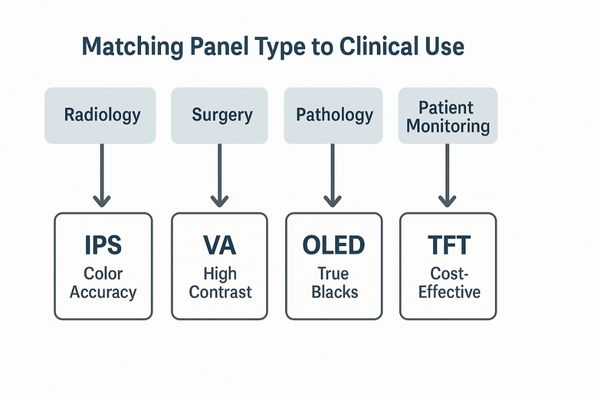
There is no single "best" panel technology for every medical application. The right choice is a strategic decision that balances clinical requirements with financial realities. A radiology department, where multiple specialists consult over complex images, requires the wide viewing angles and color accuracy of an IPS panel11. A surgeon in the OR needs the same IPS benefits, but with the added requirement of high brightness to overcome ambient lighting. In contrast, a single-user station for reviewing high-contrast images might find a VA panel suitable. For highly specialized fields like endoscopy, the perfect blacks and rapid response of an OLED panel12 might be the preferred choice. Finally, for basic information display, a cost-effective TFT (TN) panel is the most sensible option. By matching the panel technology to the task, a healthcare facility can ensure it equips its staff with the right tools. Our MD45C – Dual-screen Diagnostic Monitor (Single Panel), for example, uses a high-quality IPS panel because it is specifically designed for the demanding workflow of a radiologist’s PACS station, where accuracy and efficiency are paramount.
Clinical Application Guide for Panel Technologies
| Panel Type | Key Strength | Ideal Clinical Application |
|---|---|---|
| IPS | Color Accuracy, Wide Viewing Angle | Radiology, Surgery, Pathology, Consultation |
| VA | High Contrast Ratio | Single-user diagnostics (e.g., X-ray) |
| OLED | Perfect Black, Fast Response | Endoscopy, Cardiac Angiography |
| TFT (TN) | Low Cost, Reliability | Patient monitors, Information displays |
Conclusion
Understanding the core differences between IPS, VA, OLED, and TFT panels is key. This knowledge allows you to select the right medical display for each clinical environment, optimizing both diagnostic performance and budget.
👉 Want expert guidance on choosing the ideal medical display technology for your needs? Contact Martin at martin@reshinmonitors.com — we’re here to help you make the right choice.
-
Exploring this link will deepen your understanding of how imaging impacts patient care and clinical decisions. ↩
-
This resource will provide insights into the latest advancements in display technology crucial for medical professionals. ↩
-
Understanding IPS technology can enhance your knowledge of display quality, especially for medical imaging. ↩
-
Exploring the DICOM Part 14 standard will provide insights into the requirements for high-quality medical imaging. ↩
-
Understanding native contrast ratios helps in choosing the right display technology for your needs. ↩
-
Exploring gamma shift will provide insights into the limitations of VA panels, especially for collaborative use. ↩
-
Explore this link to understand the unique benefits of OLED technology, including its superior image quality and design flexibility. ↩
-
Learn about burn-in issues in OLED displays and discover effective solutions to mitigate this problem for better longevity. ↩
-
Understanding Thin-Film Transistors is crucial for grasping modern display technologies. Explore this link for in-depth insights. ↩
-
Learn about TN panels’ pros and cons to make informed decisions on display technology. This resource provides comprehensive details. ↩
-
Explore the benefits of IPS panels in medical settings, especially for radiology and surgery, to understand their importance in clinical environments. ↩
-
Learn why OLED technology is favored in endoscopy for its superior image quality and response time, crucial for precise medical evaluations. ↩

